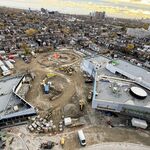Rainforest
Senior Member
They estimate that each rider on the Sheppard subway is subsidized by $10. It's a huge drain on the rest of the system. And it still doesn't have sufficient ridership to justify it being a subway!
I can't believe Mel Lastman's boondoggle is being held up as some sort of paragon of planning.
That $10 number is only true if they use the counting approach that's never applied to other transit projects. Namely, include the capital cost amortization and the interest. If we applied that method to any other major transit project, be it subway or LRT or GO expansion, they all would end up being heavily subsidized.
When TTC boasts that their cost recovery ratio is 65% or 70%, and the best in North America - they count the operating expenses only, and leave all capital investments out of the picture. By the same measure, no way each rider on the Sheppard subway is subsidized by $10.




